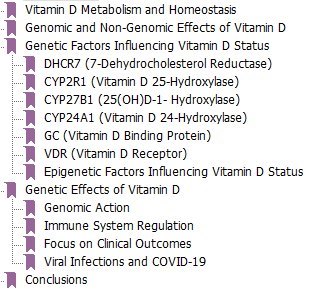Many genes can restrict Vitamin D from getting to the cells
Vitamin D: An Overview of Gene Regulation, Ranging from Metabolism to Genomic Effects
Genes 2023, 14(9), 1691; https://doi.org/10.3390/genes14091691
by Giacomo Voltan 1,2ORCID,Michele Cannito 1,2ORCID,Michela Ferrarese 1,2ORCID,Filippo Ceccato 1,2,*ORCID andValentina Camozzi 1,2
1 Department of Medicine (DIMED), University of Padova, Via Giustiniani 2, 35128 Padova, Italy
2 Endocrinology Unit, Padova University Hospital, Via Ospedale Civile 105, 35128 Padova, Italy
- Author to whom correspondence should be addressed.
PDF Table of Contents

Vitamin D Receptor structure

Vitamin D is a pro-hormone characterized by an intricate metabolism and regulation. It is well known for its role in calcium and phosphate metabolism, and in bone health. However, several studies have assessed a huge number of extra-skeletal functions, ranging from cell proliferation in some oncogenic pathways to antioxidant and immunomodulatory functions. Vitamin D exerts its role by binding to VDRs (vitamin D receptors), which are located in many different tissues. Moreover, VDRs are able to bind hundreds of genomic loci, modulating the expression of various primary target genes. Interestingly, plenty of gene polymorphisms regarding VDRs are described, each one carrying a potential influence against gene expression, with relapses in several chronic diseases and metabolic complications. In this review, we provide an overview of the genetic aspects of vitamin D and VDR, emphasizing the gene regulation of vitamin D, and the genetic modulation of VDR target genes. In addition, we briefly summarize the rare genetic disease linked to vitamin D metabolism.
Conclusions
Despite vitamin D originally having been discovered through its fundamental role in calcium homeostasis and bone formation, nowadays, vitamin D metabolism and signaling are extensively being studied for also having a critical role in extra-skeletal terms. In this context, genetic alterations affecting vitamin D metabolism might be crucial. Indeed, as reported in this review, there are several genes that, if altered, might lead to dramatic variations in 25(OH)D status , with clinical consequences that may become cumbersome, as shown in vitamin D-dependent rickets. An important aspect to keep in mind is the potential role of vitamin D as a modulator in the fields of carcinogenesis, the inflammatory response, and autoimmune diseases. However, a direct link between a potential target therapy via vitamin D supplementation is still unavailable.
Notably, in the future, new research into the role of gene polymorphism and epigenetic modifications in vitamin D status might open up new methods for the clinical application of a personalized approach. Genetic alterations, indeed, might allow physicians to identify patients who are low, medium, or high responders to vitamin D and, consequently, those who most need vitamin D supplementation.
📄 Download the PDF from VitaminDWiki
VitaminDWiki – Genetics category contains
{include}
VitaminDWiki – Some diseases reduce vitamin D getting to blood or cells
{include}
VitaminDWiki - The risk of 50+ diseases at least double with poor Vitamin D Receptor
VitaminDWiki - Vitamin D Receptor activation can be increased in many ways
{include}
There are expensive ways of estimating vitamin D in cells. but they are rarely used
Can test the PTH level: which decreases when a lot of Vitamin D gets to parathyroid cells
A >$150 test can measure Vitmin D in cells. Cells must be sample, frozen, and sent to a single test facility
Extremely little is known about the results: Example: how it varies with such things as
accuracy
reproduceability of measurements
weekly vs daily dosing
obesity,
form of vitamin D,
genes,
co-factors,
Vitamin D level in blood
time of day the sample was taken
